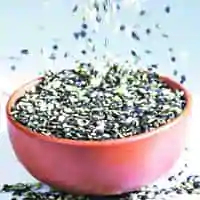If the
tandoori
chicken and the butter chicken (and its European relative, the chicken
tikka masala
) are the most famous Indian dishes in the world never to be cooked in Indian home kitchens, then there must surely be a vegetarian candidate for the same category.
I think I have found it: it is the black
dal
so beloved of Indian restaurants in India and everywhere else in the world.
When it comes to black
dal
I have to come right out and say that it is entirely out of my area of experience. I am a Gujarati and Gujaratis, in common with the rest of India, think of
dal
as being vaguely yellow in colour. We never had black
dal
at home when I was growing up and as far as I recall, most restaurants in Bombay in the sixties and early seventies also did not serve any dish that resembles the black
dal
so ubiquitous on today’s restaurant menus.
I always imagined that the
dal makhani
that we come across in restaurant menus is a Punjabi home dish. A little research suggests that I am not entirely wrong. But I am not right either.
The key to
dal makhani
is the lentil itself, the humble
urad
, called black gram in English or
masha
in Sanskrit. Of the 60
dals
that are in common use in India (
moong, chana, rajma, arhar/tuver
etc),
urad
is among the most ubiquitous and is found in many parts of the country including the south.
But there are many kinds of
urad
. And one basic distinction is between whole
urad
and broken-up
urad
. My friend Gautam Anand, who is fast becoming a mainstay of this column, tells me that his mother remembers urad
dal
from Lahore in the pre-Partition era. But, the
dal
she remembers was not made with whole
urad
. She did not see this kind of lentil used in
dal
till she came across after the Partition.
Gautam’s theory is that the Punjabis of east Punjab and of Lahore did not make a whole
urad
dal
. This was the specialty of Punjabis in Peshawar.
Dhabas
(there were relatively few restaurants in those days) sold a black
dal
made with whole
urad
and served with a few
rotis
.
When the Peshawaris came over after the Partition, they brought this
dal
with them. As many Peshawari Punjabis became restaurateurs, this was the
dal
they put on their menus.But even if you dispute the distinction between the two kinds of
urad
, what is clear is that pre-Partition Punjabis did not put tomatoes in their
dal
. If they needed a souring agent, they used yoghurt.
Why is it then, that tomato puree is now regarded as an essential ingredient of black
dal
?
Our story now veers (as does the story of the
tandoori
chicken) to Delhi’s Daryaganj where Kundan Lal Gujral, who had come over after Partition, had opened Moti Mahal and made
tandoori
meat cooking famous.
I spoke to Monish Gujral, Kundan Lal’s grandson who now runs the Moti Mahal Delux chain. According to Monish, all of Kundan Lal’s great ideas emerged out of necessity. When he began worrying about his cooked chickens drying out, he searched for a sauce with which he could rehydrate them. His solution was the
makhani
or butter sauce that led to the creation of the butter chicken, made from bits of
tandoori
chicken that were in danger of drying out.
Monish says that Kundan Lal then searched for a vegetarian option. Gautam maintains that in those days,
urad
dal
was not considered a great banqueting dish.
Chana
dal
was more respectable and in any case, caterers and restaurateurs were obsessed with so-called
shahi
dishes in which the gravy was enriched with cream.
Gautam agrees with Monish that it was Kundan Lal who invented the latter day
dal
makhani
though he suspects that it emerged out of a desire to do a
shahi
dal
to go with the rich non-vegetarian food. Monish says it was even simpler. All Kundan Lal did was to take the black
dal
of his ancestors and to add his
makhani
sauce to it. After butter chicken came, his next invention was butter
dal
. (Think about it: chicken
makhani
,
dal
makhani
! Obviously the dishes were meant to be regarded as members of the same family.)
I put this theory to Manjit Gill who is not only ITC’s corporate chef but is also extremely knowledgeable about the history of Indian cuisine. To my surprise, because hoteliers don’t like giving credit to each other, even Manjit conceded that the modern
dal
makhani
was invented by Moti Mahal. Till that version of the
dal
appeared, says Manjit, nobody thought of putting tomatoes into
dal
and no Punjabi home cook had ever mixed cream and black
dal
.
I had an ulterior motive in speaking to Manjit. Though
dal
makhani
is now a menu standard, the
dal
that has found international fame is ITC’s own
Dal
Bukhara. Foreigners come from all over the world to eat
Dal
Bukhara and ITC makes a fortune from its packaged
Dal
Bukhara which is sold all over the world.
So, is there a difference between
dal
makhani
and Dal Bukhara?
Yes, there is.
Manjit is clear that without Moti Mahal there would be no
Dal
Bukhara. Punjabi home cooking has no such
dal
. It was Kundan Lal who taught Punjabi restaurant cooks that the addition of tomato and cream could turn a simple dish into a world famous delicacy.
But equally, there are important differences between the Moti Mahal
dal
and the Bukhara version. For a start, the Moti Mahal recipe (as published in Monish’s Moti Mahal’s
Tandoori
Trail) is a mixture of
dals
. It is only 50 per cent urad
dal
. The other 50 per cent is equally divided between
rajma
and
chana
dal
. The Bukhara
dal
is all
urad
.
Manjit says that most restaurants follow the Moti Mahal recipe because the other dals add what chefs call ‘viscosity.’ (In simple English, this means that the resulting
dal
is thicker.) Moreover, the
rajma
adds a little colour.
The Bukhara
dal
gets its viscosity from slow cooking – something most restaurants don’t bother with. Like some ancient stock, it never stops cooking. The chefs cook it on a low flame overnight and then, never take it off the fire. When you order a
Dal
Bukhara, they simply ladle it out of the master pot. At most restaurants,
dal
makhani
is cooked once a day and then taken off the fire. When you order it, they heat it up again and add cream and various other kinds of dairy fat and flavouring to tart it up before service. This is why black
dal
in other restaurants is often served much hotter than the Bukhara version.
There are other differences as well. Because Moti Mahal was a way for refugees to stand on their own feet after Partition, all its dishes emerged out of improvisation. Bukhara, on the other hand, is India’s most expensive restaurant (for Indian food at least) and so, has an obsession with the quality of the lentils, sourcing them from the best farmers and then worrying incessantly about the water it uses. Any chef will tell you that water is the key to good
dal
. But water varies from city to city and frequently, urban water is either over-chlorinated or, if you use your own filters, can taste slightly odd. ITC uses mineral water to standardise the taste of its
Dal
Bukhara at all its hotels.
The obsession with detail extends to the packaged version. When they first started selling the
dal
, they were surprised by the negative feedback. ITC chefs tried the canned
dal
and discovered that it really wasn’t very good. They could not understand this. They had made the
dal
to the traditional recipe.
It took some research to work out that the
dal
had reacted with the metal of the can and its taste had changed. So, now ITC refuses to can the
dal
and sells it in sachets which preserve the taste far better. (Though of course, you can buy canned black
dal
from a variety of other companies.)
If all this has fooled you into believing that I’m a great black
dal
fan, rest assured that my interest in the invention of this dish is purely academic. I do not like the restaurant version of black
dal
and each time I eat it, I can feel my arteries harden.
My own view, for what it’s worth, is that the chefs of the Fifties and Sixties (people like Kundan Lal) did for Indian restaurants what the likes of Escoffier did for French cuisine. They created dishes, they invented sauces that became kitchen standards (the
makhani
sauce, for instance) and they established the basic north Indian menu which remained largely unchanged for the rest of the 20th century.
But these dishes were creatures of their time. Just as Escoffier was God’s gift to the dairy and milling industries because all his dishes required cream, butter and flour, the great Indian chefs of the Fifties and Sixties pursued a goal that no longer seems very interesting to us: they wanted food that tasted
shahi
or rich.
The basis of any
shahi
dish is essentially, animal fat. Take away
tandoori
meat and much of mid-20th century Indian cuisine was about fat. Chefs cooked in lots of oil, they suffused their curries with animal fat and they loved dairy fat. When they made vegetarian dishes, they compensated for the lack of meat fat by adding cow fat in the form of butter, ghee and cream. That’s why
dal
makhani
is full of cream and butter. (Kundan Lal’s recipe has one kg of dal, 500 ml of cream and a full kg of butter!
Dal
Bukhara is also something of a dairy product.)
I like to think that Indian chefs are now going back to their roots, to the traditional dishes of Indian cooking and to the food of our grandmothers who had no interest in feeding us
shahi
meals. There is a greater emphasis on spicing (
dal
makhani
and
Dal
Bukhara have hardly any spices) and a conscious effort to lighten the cuisine.
Which is great because all cuisines need to evolve. But as this evolution continues, we can still celebrate the dishes that have come to epitomise a certain kind of Indian restaurant cooking all over the world. And black
dal
, whether in its Moti Mahal
avatar
or in its currently fashionable Bukhara version, is one of the classics of 20th century Indian restaurant cuisine.





